
The Grand River land dispute, also known as the Caledonia land dispute, is an ongoing dispute between the Six Nations of the Grand River and the Government of Canada. It is focused on land along the length of the Grand River in Ontario known as the Haldimand Tract, an 385,000 hectares tract that was granted to Indigenous allies of the British Crown in 1784 to make up for territorial losses suffered as a result of the American Revolutionary War and the Treaty of Paris (1783). The Six Nations were granted the land in perpetuity and allege that lands were improperly sold, leased or given away by various Canadian governments, leaving only 5 per cent of the original lands under Six Nations control. The Six Nations also allege that monies owed to the Six Nations from leases and loans on much of the tract have not been paid or were redirected into government coffers.

Protests in Canada against the Sri Lankan Civil War, often referred to as the Tamil protests by the media, consisted of a series of demonstrations which took place in major Canadian cities with a significant Tamil diaspora population during the year 2009 protesting the alleged genocide of Sri Lankan Tamil people in the Northern Province and Eastern Province of the island nation Sri Lanka. It was part of a global outcry by the Tamil diaspora to end the Sri Lankan Civil War, investigate acts of war crimes by the Government of Sri Lanka, and restore civil rights for Tamils in Sri Lanka. The aim was also to create awareness and appeal to leaders, notably the Prime Minister of Canada, Stephen Harper, the President of the United States, Barack Obama and the Consulate General of Sri Lanka in Canada, Bandula Jayasekara, to take action in ending the conflict. Several Tamil Canadian citizens and business-owners from different parts of Canada and the United States took part in major protests set up in Toronto and Ottawa, while smaller scale demonstrations took place in Montreal, Vancouver and Calgary.
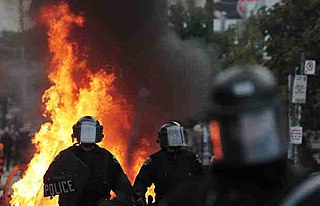
Public protesting and demonstrations began one week ahead of the 2010 G20 Toronto summit, which took place in Toronto, Ontario, Canada on 26−27 June. The protests were for various causes, including poverty and anti-capitalism.
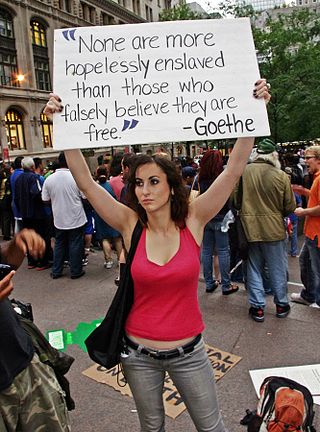
The following is a timeline of Occupy Wall Street (OWS), a protest which began on September 17, 2011 on Wall Street, the financial district of New York City and included the occupation of Zuccotti Park, where protesters established a permanent encampment. The Occupy movement splintered after NYC Mayor Bloomberg had police raid the encampment in Zuccotti Park on November 15, 2011. The timeline here is limited to this particular protest during this approximate time-frame.

Occupy Boston was a collective of protesters that settled on September 30, 2011 in Boston, Massachusetts, on Dewey Square in the Financial District opposite the Federal Reserve Bank of Boston. It is related to the Occupy Wall Street movement that began in New York City on September 17, 2011.

The Occupy movement was an international populist socio-political movement that expressed opposition to social and economic inequality and to the perceived lack of "real democracy" around the world. It aimed primarily to advance social and economic justice and different forms of democracy. The movement has had many different scopes, since local groups often had different focuses, but its prime concerns included how large corporations control the world in a way that disproportionately benefits a minority, undermines democracy and causes instability.

Occupy Buffalo was a collaboration that included a peaceful protest and demonstrations which began on October 1, 2011, in Buffalo, New York, in Niagara Square, the nexus of downtown Buffalo opposite the Buffalo City Hall. It is related to the Occupy Wall Street movement that began in New York City on September 17, and called for economic equity, accountability among politicians and ending lobbyist influence of politicians. Protesters camped overnight in Niagara Square as part of the demonstration.
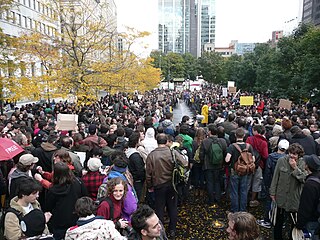
Occupy Canada was a collective of peaceful protests and demonstrations that were part of the larger Occupy Together movement which first manifested in the financial district of New York City with Occupy Wall Street, and subsequently spread to over 900 cities around the world.

Occupy London was a political movement in London, England, and part of the international Occupy movement. While some media described it as an "anti-capitalist" movement, in the statement written and endorsed by consensus by the Occupy assembly in the first two days of the occupation, occupiers defined themselves as a movement working to create alternatives to an "unjust and undemocratic" system. A second statement endorsed the following day called for "real global democracy". Due to a pre-emptive injunction, the protesters were prevented from their original aim to camp outside the London Stock Exchange. A camp was set up nearby next to St Paul's Cathedral. On 18 January 2012, Mr Justice Lindblom granted an injunction against continuation of the protest but the protesters remained in place pending an appeal. The appeal was refused on 22 February, and just past midnight on 28 February, bailiffs supported by City of London Police began to remove the tents.

Occupy Eugene was a collaboration that occurred in Eugene, Oregon based on the Occupy Wall Street movement which began in New York City on September 17, 2011. Occupy Eugene included peaceful protests and demonstrations. Protesters were concerned about inequities in the distribution of wealth, banking regulation, housing issues and corporate greed. The first protest march was held on October 15, 2011. The march started at the Wayne Morse Free Speech Plaza and continued downtown before marching over Ferry Street Bridge. It was reported that close to 2000 people were in attendance from all over the state of Oregon. Occupy Eugene continued to hold regular protests and actions until it left the encampment in December 2011. Protesters have stated that they do not have a set group of leaders. Occupy Eugene General Assemblies have met from as frequently as twice a day at times during active occupations, and as infrequently as weekly. Many committees have met since at least the third General Assembly, typically weekly. Decisions are made through a process known as consensus. Occupy Eugene's consensus process operates in a similar fashion to how consensus is being handled in New York City by protesters involved in Occupy Wall Street. Although the exact method varies from Occupation to Occupation. As of October 18, 2011, The Eugene police department was allowing protesters to camp in downtown Eugene, although city law prohibits it. Eugene police also stated that downtown camping won't be permanently allowed.
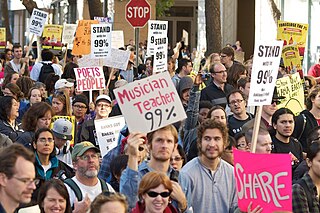
Occupy Oakland refers to a collaboration and series of demonstrations in Oakland, California, that started in October 2011. As part of the Occupy movement, protestors have staged occupations, most notably at Frank H. Ogawa Plaza in front of Oakland City Hall.
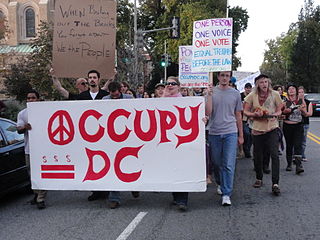
Occupy D.C. was an occupation of public space in Washington, D.C. based at McPherson Square and connected to the Occupy movements that sprung up across the United States in Fall 2011. The group had been demonstrating in McPherson Square since October 1, 2011, and in Freedom Plaza since October 6. Despite crackdowns on other Occupy projects across the country, federal authorities claimed on November 15 that they have no plans to clear McPherson Square Park. The National Park Service decided against eviction after meeting with activists and discussing health and safety conditions.

Occupy Movement protests took place in New Zealand, beginning on 15 October 2011 with the Occupation of Auckland. Occupy protests took place in Auckland, New Plymouth, Wellington, Lower Hutt, Christchurch, Dunedin, and Invercargill.

The Occupy movement began in the United States initially with the Occupy Wall Street protests in New York City, but spread to many other cities, both in the United States and worldwide. This list article is an alphabetical, non-chronological summary of Occupy events that have occurred in cities in the United States.

Occupy St. Louis (OccupySTL) was a postpartisan people's movement that began on October 1, 2011 as a peaceful protest against corporate greed, its influence over the economy, its corruption of government, and ensuing inequality. Although people possess differing viewpoints and diversity of views is a central tenet, commonly held themes seek an equal playing field in the economy with more equal opportunities for all people as well as accountability for corporate and financial malfeasance. Many of those in the movement argue that structural, systemic change is necessary and that incremental reform is insufficient and in any case not possible without popular countervailing power to the power of moneyed interests. Occupy St. Louis is in solidarity with the Occupy Wall Street movement. It is located at Kiener Plaza in downtown St. Louis near an area which includes many financial institutions such as commercial banks and the Federal Reserve Bank of St. Louis.
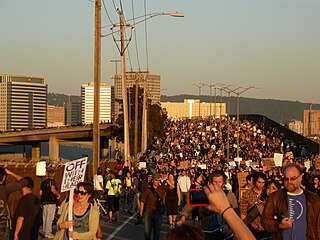
The following is a timeline of Occupy Oakland which began on Monday, October 10, 2011, as an occupation of Frank H. Ogawa Plaza located in front of Oakland City Hall in downtown Oakland, and is an ongoing demonstration. It is allied with Occupy Wall Street, which began in New York City on September 17, 2011, and is one of several "Occupy" protest sites in the San Francisco Bay Area. Other sites include Occupy San Francisco and Occupy San Jose.
Occupy Windsor was an Occupy movement encampment in David Croll Park, Windsor, Ontario, Canada. The protest ended and all protesters evacuated the area on December 12, 2011 with promises to return to the park to reseed areas damaged by the camp.

Occupy Ottawa was a mostly peaceful, leaderless, grassroots and democratic protest movement that began on Confederation Park in Ottawa, Ontario, on October 15, 2011. The movement's slogan "Home of the global revolution in Ottawa" refers to its inspiration by, and association with, the Arab Spring, Occupy Wall Street and the global Occupy Movement, which protests growing economic inequality, corporate greed, and the influence of corporations and lobbyists on electoral politics and government. Occupy Ottawa seeks global economic, social, political and environmental justice.

Occupy Minneapolis (OccupyMN) is a grassroots collaboration that began in October 2011 with a series of demonstrations in Minneapolis, Minnesota. Protesters have staged numerous occupations, most notably of the Hennepin County Government Center plaza.

Umbrella Square, also called Umbrella Plaza, describes a large roadway in Admiralty, Hong Kong occupied by protesters during the Umbrella Movement protests in September 2014. On 11 December 2014, after 74 days of occupation, the area was cleared by the police and reopened to motorised traffic.
































